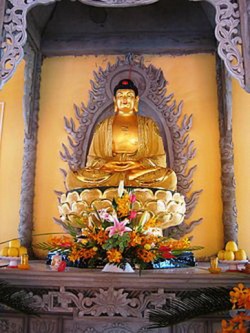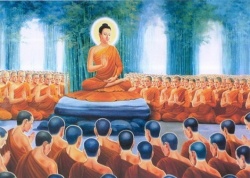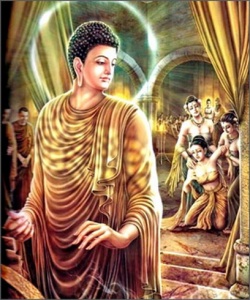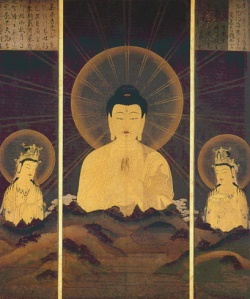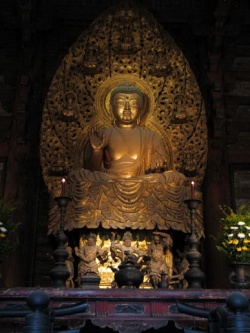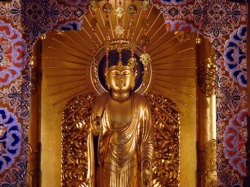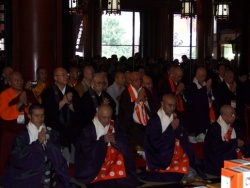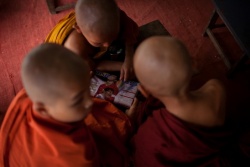Difference between revisions of "The Influence of The 108 Defilements and Other Buddhist Concepts on Karate Thought and Practice"
| (One intermediate revision by the same user not shown) | |||
| Line 1: | Line 1: | ||
[[File:Phật A-di-đà.jpg|thumb|250px|]] | [[File:Phật A-di-đà.jpg|thumb|250px|]] | ||
| + | |||
| + | |||
| + | |||
| + | |||
| + | |||
| + | |||
| + | |||
| + | |||
| + | |||
<poem> | <poem> | ||
| − | It was just after the end of [[World]] [[War]] II -- American troops occupied the island of Okinawa -- and the six year old child had been sent to [[live]] in the village of Aha, his mother's hometown. On this particular morning his maternal aunt had taken him to a nearby [[Buddhist temple]] perched among the pines on the slope of a steep hill. From the narrow road, down below, the moss-covered stone steps leading up to the [[shrine]] rose in a straight line, seeming to the boy to almost {{Wiki|touch}} the sky itself. | + | It was just after the end of [[World]] [[War]] II -- [[American]] troops occupied the [[island]] of Okinawa -- and the six year old child had been sent to [[live]] in the village of Aha, his mother's hometown. On this particular morning his maternal aunt had taken him to a nearby [[Buddhist temple]] perched among the pines on the slope of a steep [[hill]]. From the narrow road, down below, the moss-covered stone steps leading up to the [[shrine]] rose in a straight line, seeming to the boy to almost {{Wiki|touch}} the sky itself. |
Up the steps he climbed, one after the other, until at last he reached the simple wooden [[shrine]]. He turned and looked down at the [[108]] steps and the road, which now looked a [[world]] away. | Up the steps he climbed, one after the other, until at last he reached the simple wooden [[shrine]]. He turned and looked down at the [[108]] steps and the road, which now looked a [[world]] away. | ||
| − | Fifty years later, the boy, now a [[Zen]] [[priest]] at the Daihonzan Chozenji Temple/International [[Zen]] [[Dojo]] and kyoshi, seventh dan of Matsubayashi Ryu, called me at my office in Aiea, Hawaii, and asked, "Charles, do you know why the [[kata]] Gojushiho is called that?" I [[thought]] to myself that it must be because the [[kata]] has 54 (or gojushi, in [[Japanese]] numbering) movements or steps (ho). (1) Before I could answer, Zenko Heshiki [[sensei]] added (2), "--And it's not because it has 54 movements because it doesn't, no {{Wiki|matter}} how you count it." | + | Fifty years later, the boy, now a [[Zen]] [[priest]] at the Daihonzan Chozenji Temple/International [[Zen]] [[Dojo]] and kyoshi, seventh dan of Matsubayashi [[Ryu]], called me at my office in Aiea, [[Hawaii]], and asked, "Charles, do you know why the [[kata]] Gojushiho is called that?" I [[thought]] to myself that it must be because the [[kata]] has 54 (or gojushi, in [[Japanese]] numbering) movements or steps (ho). (1) Before I could answer, Zenko Heshiki [[sensei]] added (2), "--And it's not because it has 54 movements because it doesn't, no {{Wiki|matter}} how you count it." |
| − | Thereby confessing my [[ignorance]], Heshiki [[sensei]] thus began to explain the influence of the {{Wiki|concept}} of the [[108]] [[Defilements]] (Hyaku [[Hachi]] No [[Bonno]]) of [[Buddhism]] on karate. | + | Thereby confessing my [[ignorance]], Heshiki [[sensei]] thus began to explain the influence of the {{Wiki|concept}} of the [[108]] [[Defilements]] (Hyaku [[Hachi]] No [[Bonno]]) of [[Buddhism]] on [[karate]]. |
| − | According to Heshiki, it is an {{Wiki|Asian}} predilection to embody profound [[Wikipedia:concept|concepts]], such as The [[108]] [[Defilements]], in ordinary things. Profound inner meanings are captured in [[mundane]], outer [[forms]]. To the casual sojourner, the steps leading up to a [[Buddhist temple]] are a mere convenience--they simply are there. But after several visits, a more inquisitive [[person]] might ask, "Why do these [[108]] steps lead up to the [[shrine]]? Why not put the [[shrine]] closer to the road, a little lower on the hill? Why have any steps at all?" | + | According to Heshiki, it is an {{Wiki|Asian}} predilection to embody profound [[Wikipedia:concept|concepts]], such as The [[108]] [[Defilements]], in ordinary things. Profound inner meanings are captured in [[mundane]], outer [[forms]]. To the [[casual]] sojourner, the steps leading up to a [[Buddhist temple]] are a mere convenience--they simply are there. But after several visits, a more inquisitive [[person]] might ask, "Why do these [[108]] steps lead up to the [[shrine]]? Why not put the [[shrine]] closer to the road, a little lower on the [[hill]]? Why have any steps at all?" |
[[File:Zusammenkunft.jpg|thumb|250px|]] | [[File:Zusammenkunft.jpg|thumb|250px|]] | ||
The answer is not inscribed on the steps, at the [[shrine]], or on any sign or guidebook. Instead, the steps themselves are the message in plain [[view]] for the [[world]] to see. The {{Wiki|architect}} carved his [[symbolism]] and meaning into the landscape. | The answer is not inscribed on the steps, at the [[shrine]], or on any sign or guidebook. Instead, the steps themselves are the message in plain [[view]] for the [[world]] to see. The {{Wiki|architect}} carved his [[symbolism]] and meaning into the landscape. | ||
| − | The occurrences of [[108]] steps leading to [[Buddhist]] [[temples]] are common. (3) Sometimes they rise in a single flight. Depending on the terrain, they might consist of two flights of 54 steps or three flights of 36 steps. Years after, when Heshiki [[sensei]] as an adult returned to the same Aha [[shrine]] with his aunt, he knew without counting that it had [[108]] steps. Through his [[Zen]] and karate training he had come to understand the meaning behind the [[symbolism]]. | + | The occurrences of [[108]] steps leading to [[Buddhist]] [[temples]] are common. (3) Sometimes they rise in a single flight. Depending on the terrain, they might consist of two flights of 54 steps or three flights of 36 steps. Years after, when Heshiki [[sensei]] as an adult returned to the same Aha [[shrine]] with his aunt, he knew without counting that it had [[108]] steps. Through his [[Zen]] and [[karate]] {{Wiki|training}} he had come to understand the meaning behind the [[symbolism]]. |
Heshiki [[sensei]] explained that all major [[schools of Buddhism]] have long [[recognized]] the [[existence]] of [[108]] [[Defilements]], which are so named because these faults [[cause]] both the [[body]] and [[mind]] to be afflicted and to [[suffer]]. (4) From the {{Wiki|Western}} point of [[view]], they might be defined as [[human]] propensities which lead toward [[sin]] or wrongdoing. The term [[defilement]] is further explained as that which disturbs the [[mind]] and [[body]] and prevents [[tranquility]]. [[Defilements]] are classified by the [[three realms]] in which they [[exist]]: [[desire]], [[form]] and [[formlessness]]. | Heshiki [[sensei]] explained that all major [[schools of Buddhism]] have long [[recognized]] the [[existence]] of [[108]] [[Defilements]], which are so named because these faults [[cause]] both the [[body]] and [[mind]] to be afflicted and to [[suffer]]. (4) From the {{Wiki|Western}} point of [[view]], they might be defined as [[human]] propensities which lead toward [[sin]] or wrongdoing. The term [[defilement]] is further explained as that which disturbs the [[mind]] and [[body]] and prevents [[tranquility]]. [[Defilements]] are classified by the [[three realms]] in which they [[exist]]: [[desire]], [[form]] and [[formlessness]]. | ||
| Line 23: | Line 32: | ||
The [[Truth]] of [[Cause]]: [[suffering]] is [[caused]] by [[ignorance]], which gives rise to [[craving]] and [[illusion]]. | The [[Truth]] of [[Cause]]: [[suffering]] is [[caused]] by [[ignorance]], which gives rise to [[craving]] and [[illusion]]. | ||
| − | The [[Truth]] of [[Extinction]]: there is an end to [[suffering]] (this nonsuffering state is called [[Nirvana]]); and | + | The [[Truth]] of [[Extinction]]: there is an end to [[suffering]] (this nonsuffering [[state]] is called [[Nirvana]]); and |
The [[Truth]] of the [[Path]]: [[Nirvana]] is [[attained]] through the practice of the [[Eightfold Path]]. | The [[Truth]] of the [[Path]]: [[Nirvana]] is [[attained]] through the practice of the [[Eightfold Path]]. | ||
| − | The [[Four Noble Truths]] lie at the [[heart]] of [[Buddhist doctrine]], and were the four [[essential]] [[Wikipedia:concept|concepts]] that the historical [[Shakyamuni Buddha]] discovered upon his [[enlightenment]] under a [[bodhi tree]]. It describes, in highly [[logical]] terms, a situation, the [[cause]] of the situation, the [[belief]] that the situation can be alleviated, and that there is a way, or solution to the situation. The solution, the [[Eightfold Path]], is a prescription of [[proper behavior]]: | + | The [[Four Noble Truths]] lie at the [[heart]] of [[Buddhist doctrine]], and were the four [[essential]] [[Wikipedia:concept|concepts]] that the historical [[Shakyamuni Buddha]] discovered upon his [[enlightenment]] under a [[bodhi tree]]. It describes, in highly [[logical]] terms, a situation, the [[cause]] of the situation, the [[belief]] that the situation can be alleviated, and that there is a way, or {{Wiki|solution}} to the situation. The {{Wiki|solution}}, the [[Eightfold Path]], is a prescription of [[proper behavior]]: |
| − | [[right view]]; [[right thinking]]; [[right speech]]; [[right action]]; right living; [[right effort]]; [[right memory]]; and [[right meditation]]. | + | [[right view]]; [[right thinking]]; [[right speech]]; [[right action]]; [[right living]]; [[right effort]]; [[right memory]]; and [[right meditation]]. |
The four remaining proclivities in the [[realm of desire]] are cut off through [[meditation]]. | The four remaining proclivities in the [[realm of desire]] are cut off through [[meditation]]. | ||
| Line 35: | Line 44: | ||
Thirty-one proclivities are found in each of the two [[higher realms]] of [[form]] and [[formlessness]]. Adding the 36 proclivities of the [[realm of desire]], 31 proclivities of the [[realm of form]], and 31 proclivities of the [[realm of formlessness]], a total of 98 proclivities is [[attained]]. To this total, 10 bonds-or secondary defilements-are added, resulting in a total of [[108]] [[defilements]]. | Thirty-one proclivities are found in each of the two [[higher realms]] of [[form]] and [[formlessness]]. Adding the 36 proclivities of the [[realm of desire]], 31 proclivities of the [[realm of form]], and 31 proclivities of the [[realm of formlessness]], a total of 98 proclivities is [[attained]]. To this total, 10 bonds-or secondary defilements-are added, resulting in a total of [[108]] [[defilements]]. | ||
[[File:Yamagoe.jpg|thumb|250px|]] | [[File:Yamagoe.jpg|thumb|250px|]] | ||
| − | Upon the exhaustion or elimination of the [[108]] [[Defilements]] through shugyo (the austere practice of bodymind {{Wiki|transcendence}}), one enters a [[state of enlightenment]]. | + | Upon the exhaustion or elimination of the [[108]] [[Defilements]] through shugyo (the [[austere]] practice of bodymind {{Wiki|transcendence}}), one enters a [[state of enlightenment]]. |
| − | The meaning of the [[108]] steps leading to [[Buddhist]] [[temples]] now becomes clear. As each of the steps are climbed and a [[defilement]] is [[symbolically]] eliminated, the seeker's [[true nature]] becomes less and less obscured and afflicted. By the [[time]] the [[shrine]] is reached, the seeker is [[symbolically]] ready for [[enlightenment]], the state of nonsuffering. In this case, the numeric [[symbol]] [[108]] is combined by the [[action]] of climbing, which itself is a powerful [[symbol]] of striving. | + | The meaning of the [[108]] steps leading to [[Buddhist]] [[temples]] now becomes clear. As each of the steps are climbed and a [[defilement]] is [[symbolically]] eliminated, the seeker's [[true nature]] becomes less and less obscured and afflicted. By the [[time]] the [[shrine]] is reached, the seeker is [[symbolically]] ready for [[enlightenment]], the [[state]] of nonsuffering. In this case, the numeric [[symbol]] [[108]] is combined by the [[action]] of climbing, which itself is a powerful [[symbol]] of striving. |
| − | The number [[108]] is also found in other [[symbols]] and [[rituals]] of [[Buddhism]]. [[Zen]] {{Wiki|priests}} wear juzu (a ring of "[[prayer beads]]") around their wrists, which consists of [[108]] beads and are used somewhat like a {{Wiki|Christian}} rosary. In addition, the large [[bell]] in [[Buddhist]] [[temples]] is struck [[108]] times on [[New Year's]] Eve to represent the elimination of the [[defilements]]. (5) In Hawaii as well as [[Japan]], members of some [[temples]] each take a turn at the [[bell]] until it is tolled a total of [[108]] times. In addition, one of the features of large [[temple bells]], an area called the chinomachi, consists of an arrangement of [[108]] knots or knobs. | + | The number [[108]] is also found in other [[symbols]] and [[rituals]] of [[Buddhism]]. [[Zen]] {{Wiki|priests}} wear [[juzu]] (a ring of "[[prayer beads]]") around their wrists, which consists of [[108]] [[beads]] and are used somewhat like a {{Wiki|Christian}} rosary. In addition, the large [[bell]] in [[Buddhist]] [[temples]] is struck [[108]] times on [[New Year's]] Eve to represent the elimination of the [[defilements]]. (5) In [[Hawaii]] as well as [[Japan]], members of some [[temples]] each take a turn at the [[bell]] until it is tolled a total of [[108]] times. In addition, one of the features of large [[temple bells]], an area called the chinomachi, consists of an arrangement of [[108]] knots or knobs. |
| − | [[Symbolism]] of the [[108]] [[Defilements]] in Karate | + | [[Symbolism]] of the [[108]] [[Defilements]] in [[Karate]] |
| − | It cannot be denied that the founders of various [[forms]] of karatedo were heavily influenced by [[Buddhism]]. The expression ken [[Zen]] ichinyo or "fist and [[Zen]] as one" describes how karate is still taught in some traditional-bent [[dojo]]. Ideally, there should be no separation between the two. Just as [[symbolism]] of the [[108]] [[Defilements]] was captured in stone steps, juzu, and [[temple bells]], so too was it preserved in the names and movements of certain karate [[kata]]. | + | It cannot be denied that the founders of various [[forms]] of karatedo were heavily influenced by [[Buddhism]]. The expression ken [[Zen]] ichinyo or "fist and [[Zen]] as one" describes how [[karate]] is still [[taught]] in some traditional-bent [[dojo]]. Ideally, there should be no separation between the two. Just as [[symbolism]] of the [[108]] [[Defilements]] was captured in stone steps, [[juzu]], and [[temple bells]], so too was it preserved in the names and movements of certain [[karate]] [[kata]]. |
[[File:Yakushi-nyorai01a.jpg|thumb|250px|]] | [[File:Yakushi-nyorai01a.jpg|thumb|250px|]] | ||
| − | When Heshiki [[sensei]] called me about the Shorin-ryu [[kata]] Gojushiho, he naturally knew that 54 is one-half of the [[108]] steps or [[defilements]]. It is also noteworthy that there are 18 [[kata]] in Matsubayashi Ryu. When a [[Buddhist]] sees numbers which are major factors of [[108]] (such as 54, 36 and 18), he is reminded of the [[Defilements]]. Think again about the flights of stairs leading to a [[Buddhist]] [[shrine]]. The [[path]] might lead up 36 steps, turn to the left for another 36, and finally veer right for the final 36. Each flight is instantly [[recognized]] as a portion of the whole number, or [[108]]. Numeric [[symbolism]] is also {{Wiki|present}} in the karate style known as Goju-ryu. The [[Wikipedia:Absolute (philosophy)|ultimate]] Goju-ryu [[kata]], Suparinpei, literally means [[108]]. Suparinpei is the {{Wiki|Chinese}} (somewhat Japanicized) pronunciation of the number [[108]], while gojushi of gojushiho is the [[Japanese]] pronunciation of the number 54. The other Goju-ryu [[kata]], Sanseru (meaning "36") and Seipai ("18") are factors of the number [[108]]. Heshiki is quick to point out that he is a [[teacher]] of Matsubayashi Ryu, not Goju-ryu, and does not presume to speak for that ryu or its founders, but the coincidence of the numbers is truly striking and surely must go [[beyond]] mere coincidence. | + | When Heshiki [[sensei]] called me about the Shorin-ryu [[kata]] Gojushiho, he naturally knew that 54 is one-half of the [[108]] steps or [[defilements]]. It is also noteworthy that there are 18 [[kata]] in Matsubayashi [[Ryu]]. When a [[Buddhist]] sees numbers which are major factors of [[108]] (such as 54, 36 and 18), he is reminded of the [[Defilements]]. Think again about the flights of stairs leading to a [[Buddhist]] [[shrine]]. The [[path]] might lead up 36 steps, turn to the left for another 36, and finally veer right for the final 36. Each flight is instantly [[recognized]] as a portion of the whole number, or [[108]]. Numeric [[symbolism]] is also {{Wiki|present}} in the [[karate]] style known as Goju-ryu. The [[Wikipedia:Absolute (philosophy)|ultimate]] Goju-ryu [[kata]], Suparinpei, literally means [[108]]. Suparinpei is the {{Wiki|Chinese}} (somewhat Japanicized) pronunciation of the number [[108]], while gojushi of gojushiho is the [[Japanese]] pronunciation of the number 54. The other Goju-ryu [[kata]], Sanseru (meaning "36") and Seipai ("18") are factors of the number [[108]]. Heshiki is quick to point out that he is a [[teacher]] of Matsubayashi [[Ryu]], not Goju-ryu, and does not presume to speak for that ryu or its founders, but the coincidence of the numbers is truly striking and surely must go [[beyond]] mere coincidence. |
| − | Keeping in [[mind]] that [[Buddhism]] originated in [[India]] and traveled to [[Japan]] through [[China]], it should not be surprising to find {{Wiki|Chinese}} [[symbols]] of the [[108]] [[Defilements]]. The legendary [[Shaolin Temple]], from which are traced many {{Wiki|Chinese}} boxing styles, was [[Buddhist]] and it is from the {{Wiki|Chinese}} [[name]] [[Shaolin]] that Shorin of Shorin-ryu systems derived their [[name]]. In T'ai [[Chi]] Ch'uan and certain [[forms]] of gung fu, for example, there are sets that are supposed to consist of [[108]] movements. In the {{Wiki|Chinese}} [[healing]] [[arts]], as well, there is also mention of [[108]] major [[energy]] points. | + | Keeping in [[mind]] that [[Buddhism]] originated in [[India]] and traveled to [[Japan]] through [[China]], it should not be surprising to find {{Wiki|Chinese}} [[symbols]] of the [[108]] [[Defilements]]. The legendary [[Shaolin Temple]], from which are traced many {{Wiki|Chinese}} [[boxing]] styles, was [[Buddhist]] and it is from the {{Wiki|Chinese}} [[name]] [[Shaolin]] that Shorin of Shorin-ryu systems derived their [[name]]. In T'ai [[Chi]] [[Ch'uan]] and certain [[forms]] of [[gung fu]], for example, there are sets that are supposed to consist of [[108]] movements. In the {{Wiki|Chinese}} [[healing]] [[arts]], as well, there is also mention of [[108]] major [[energy]] points. |
| − | Karate As Shugyo | + | [[Karate]] As Shugyo |
| − | "Everything is apparent in black in white," says Heshiki, "but without shugyo, [[intellectual]] [[understanding]] is useless." It is one thing to [[mentally]] digest the meaning of the [[108]] [[Defilements]]. It is quite another thing to diligently work to eliminate them. While [[zazen]], or sitting [[meditation]], is the most widely [[recognized]] [[form]] of shugyo, Karate itself can and should be practiced as a [[form]] of shugyo. | + | "Everything is apparent in black in white," says Heshiki, "but without shugyo, [[intellectual]] [[understanding]] is useless." It is one thing to [[mentally]] digest the meaning of the [[108]] [[Defilements]]. It is quite another thing to diligently work to eliminate them. While [[zazen]], or sitting [[meditation]], is the most widely [[recognized]] [[form]] of shugyo, [[Karate]] itself can and should be practiced as a [[form]] of shugyo. |
[[File:Uddha.55.jpg|thumb|250px|]] | [[File:Uddha.55.jpg|thumb|250px|]] | ||
| − | According to Heshiki, kata--the true [[essence]] of karate--represents steps to eliminate the [[108]] [[Defilements]], thus leading to the [[state of enlightenment]]. Through the intense practice of [[kata]], the student literally climbs the steps or strikes the [[temple bell]] of the [[Self]]. With a gleam in his [[eyes]], Heshiki likes to say that the student must literally "burn himself in [[kata]]." He further explains: | + | According to Heshiki, kata--the true [[essence]] of karate--represents steps to eliminate the [[108]] [[Defilements]], thus leading to the [[state of enlightenment]]. Through the intense practice of [[kata]], the [[student]] literally climbs the steps or strikes the [[temple bell]] of the [[Self]]. With a gleam in his [[eyes]], Heshiki likes to say that the [[student]] must literally "burn himself in [[kata]]." He further explains: |
| − | Through the years of practice the trained [[body]] will execute every {{Wiki|movement}} with unbroken {{Wiki|fluidity}}. One no longer [[knows]] the difference of mindbody. To get that far, for the skill to become [[spiritual]], a [[concentration]] of all the [[physical]] and [[psychic]] forces is needed. This is the general [[attitude]] of {{Wiki|Oriental}} [[people]] approaching any [[art]]. They have developed [[arts]] such as karatedo (The Way of Karate), kendo (The Way of the Sword), [[judo]] (The Way of [[Suppleness]]), [[kyudo]] (The Way of [[Archery]]), and also [[flower]] arrangement, and tea {{Wiki|ceremony}}. It is the aim of every artist to achieve such a [[state of mind]], so that he no longer has to rely on the techniques he has learned, but transcends into the [[realm]] of [[nature]] and [[lives]] completely in tune with the whole of [[Nature]] and the [[truth]] of the whole. | + | Through the years of practice the trained [[body]] will execute every {{Wiki|movement}} with unbroken {{Wiki|fluidity}}. One no longer [[knows]] the difference of mindbody. To get that far, for the skill to become [[spiritual]], a [[concentration]] of all the [[physical]] and [[psychic]] forces is needed. This is the general [[attitude]] of {{Wiki|Oriental}} [[people]] approaching any [[art]]. They have developed [[arts]] such as karatedo (The Way of [[Karate]]), [[kendo]] (The Way of the Sword), [[judo]] (The Way of [[Suppleness]]), [[kyudo]] (The Way of [[Archery]]), and also [[flower]] arrangement, and tea {{Wiki|ceremony}}. It is the aim of every artist to achieve such a [[state of mind]], so that he no longer has to rely on the [[techniques]] he has learned, but {{Wiki|transcends}} into the [[realm]] of [[nature]] and [[lives]] completely in tune with the whole of [[Nature]] and the [[truth]] of the whole. |
| − | (From the booklet Karate, by Zenko Heshiki, Chozenji, International [[Zen]] [[Dojo]], currently out of print.) | + | (From the booklet [[Karate]], by Zenko Heshiki, Chozenji, International [[Zen]] [[Dojo]], currently out of print.) |
| − | [[Kata]] is shugyo, punching and blocking is shugyo, kumite (sparring) is shugyo. . . practiced properly, every aspect of karate is shugyo. | + | [[Kata]] is shugyo, punching and blocking is shugyo, kumite (sparring) is shugyo. . . practiced properly, every aspect of [[karate]] is shugyo. |
| − | Other [[Buddhist Symbols]] In Karate | + | Other [[Buddhist Symbols]] In [[Karate]] |
| − | Heshiki made me start to think about other [[Buddhist symbols]] {{Wiki|present}} in karate. One of the most obvious is the term karate itself. As described in my previous article about Heshiki, the [[character]] [[kara]] can also be read as ku, which: | + | Heshiki made me start to think about other [[Buddhist symbols]] {{Wiki|present}} in [[karate]]. One of the most obvious is the term [[karate]] itself. As described in my previous article about Heshiki, the [[character]] [[kara]] can also be read as ku, which: |
[[File:WFB-7.JPG|thumb|250px|]] | [[File:WFB-7.JPG|thumb|250px|]] | ||
[O]riginates from [[sunya]], the small circle called zero in {{Wiki|modern}} {{Wiki|mathematics}}. [[Sunya]] or [[sunyata]] is the [[Sanskrit]] term for [[void]], [[emptiness]], or the absence of [[duality]] and [[conceptualization]]. [[Nothing]] [[exists]] in ku but all things spring out of it. It is something like a [[mirror]]. Although [[nothing]] [[exists]] in a [[mirror]], it is possible to reflect everything in it. (From Furyu #5, Winter 1995, page 53.) | [O]riginates from [[sunya]], the small circle called zero in {{Wiki|modern}} {{Wiki|mathematics}}. [[Sunya]] or [[sunyata]] is the [[Sanskrit]] term for [[void]], [[emptiness]], or the absence of [[duality]] and [[conceptualization]]. [[Nothing]] [[exists]] in ku but all things spring out of it. It is something like a [[mirror]]. Although [[nothing]] [[exists]] in a [[mirror]], it is possible to reflect everything in it. (From Furyu #5, Winter 1995, page 53.) | ||
| − | Heshiki thus translates karate not as "[[empty]] hand" in the [[sense]] of being "weaponless" but rather as "the hand which [[emanates]] from the [[Void]]." This [[phrase]] is beautifully illustrated in the most advanced Matsubayashi Ryu [[kata]], Kusanku, which was named in {{Wiki|honor}} of an the eighteenth century {{Wiki|Chinese}} {{Wiki|martial}} artist who came to Okinawa. Kusanku is the Okinawan pronunciation of the {{Wiki|Chinese}} [[master's]] [[name]]. | + | Heshiki thus translates [[karate]] not as "[[empty]] hand" in the [[sense]] of being "weaponless" but rather as "the hand which [[emanates]] from the [[Void]]." This [[phrase]] is beautifully illustrated in the most advanced Matsubayashi [[Ryu]] [[kata]], Kusanku, which was named in {{Wiki|honor}} of an the eighteenth century {{Wiki|Chinese}} {{Wiki|martial}} artist who came to Okinawa. Kusanku is the Okinawan pronunciation of the {{Wiki|Chinese}} [[master's]] [[name]]. |
In The [[Essence]] of Okinawan Karate-Do, Nagamine [[Shoshin]] writes that the [[kata]] requires "painstaking practice of more than a decade for [[mastery]]" (page 230). | In The [[Essence]] of Okinawan Karate-Do, Nagamine [[Shoshin]] writes that the [[kata]] requires "painstaking practice of more than a decade for [[mastery]]" (page 230). | ||
| − | The student begins the [[kata]] with his feet at shoulder width and his hands placed in a lower position with the left over the right (as in Fukyugata Ichi). From there, he raises both hands straight up over his head and then brings them down on each side, tracing the perimeter of a giant circle, representative of the [[Void]]. As the {{Wiki|calligrapher}} or shodoka expresses his [[spirit]] through brush and ink in depicting the enso (a {{Wiki|calligraphic}} circle that describes the [[energy]] and [[spirit]] of the artist), the karateka expresses his [[spirit]] through the movements of the [[kata]]. And like the enso, the beginning of Kusanku is a great circle with a definite beginning and ending point. All the [[kata]] in Matsubayashi Ryu and many other styles, in fact, begin and end at the same spot. | + | The [[student]] begins the [[kata]] with his feet at shoulder width and his hands placed in a lower position with the left over the right (as in Fukyugata Ichi). From there, he raises both hands straight up over his head and then brings them down on each side, tracing the perimeter of a giant circle, representative of the [[Void]]. As the {{Wiki|calligrapher}} or shodoka expresses his [[spirit]] through brush and ink in depicting the enso (a {{Wiki|calligraphic}} circle that describes the [[energy]] and [[spirit]] of the artist), the karateka expresses his [[spirit]] through the movements of the [[kata]]. And like the enso, the beginning of Kusanku is a great circle with a definite beginning and ending point. All the [[kata]] in Matsubayashi [[Ryu]] and many other styles, in fact, begin and end at the same spot. |
| − | -- And have you noticed that we always [[bow]] when entering and leaving the [[dojo]] and meeting our [[sensei]], just as is done in [[Buddhist]] [[temples]] and [[Zen]] [[dojo]]? (6) Have you heard that the top portion of the gi is alwayscrossed left over right as is customary in [[Japanese]] {{Wiki|culture}}, except for the [[dead]]. . . and the [[Buddha]]? Have you wondered why the hands are positioned at the beginning of [[kata]] almost identically to the hand position of [[zazen]]? Have you heard of [[kata]] referred to as "moving [[Zen]]"? After years of [[constant]] intrusion of these tidbits of fact upon our [[consciousness]], one must begin to wonder. | + | -- And have you noticed that we always [[bow]] when entering and leaving the [[dojo]] and meeting our [[sensei]], just as is done in [[Buddhist]] [[temples]] and [[Zen]] [[dojo]]? (6) Have you heard that the top portion of the gi is alwayscrossed left over right as is customary in [[Japanese]] {{Wiki|culture}}, except for the [[dead]]. . . and the [[Buddha]]? Have you wondered why the hands are positioned at the beginning of [[kata]] almost identically to the hand position of [[zazen]]? Have you heard of [[kata]] referred to as "moving [[Zen]]"? After years of [[constant]] intrusion of these tidbits of fact upon our [[consciousness]], one must begin to [[wonder]]. |
[[File:Urma-9.jpg|thumb|250px|]] | [[File:Urma-9.jpg|thumb|250px|]] | ||
| − | In [[time]], the karateka learns how to execute the basic movements of [[kata]] and [[understands]] the [[kata]] bunkai (application). Self-defense skills are thoroughly developed and the [[body]] and [[mind]] are strengthened. At some point the student must ask, however, is that all there is? Is karate solely directed to the external and gauged in terms of the [[actions]] of others? Are rank, titles and tournament performance really accurate measures of the [[self]]? How much selfdefense is really necessary? | + | In [[time]], the karateka learns how to execute the basic movements of [[kata]] and [[understands]] the [[kata]] bunkai (application). [[Self-defense]] skills are thoroughly developed and the [[body]] and [[mind]] are strengthened. At some point the [[student]] must ask, however, is that all there is? Is [[karate]] solely directed to the external and gauged in terms of the [[actions]] of others? Are rank, titles and tournament performance really accurate measures of the [[self]]? How much selfdefense is really necessary? |
| − | At that crucial moment, with the strength and intensity the student has cultivated through years of practice, the [[symbolism]] of the [[108]] [[Defilements]] and other [[Buddhist]] [[Wikipedia:concept|concepts]] might come to [[mind]]. The karateka might recall the [[visual]] [[symbols]] of the steps leading to [[Buddhist]] [[shrines]], of the striking of [[temple bells]], and particularly the names or number of movements of various [[kata]]. He/she might even begin to turn his [[attention]] inward and start the [[essential]] process of working on his inner [[self]] in earnest, in shugyo and of truly "burning himself in [[kata]]." | + | At that crucial [[moment]], with the strength and intensity the [[student]] has cultivated through years of practice, the [[symbolism]] of the [[108]] [[Defilements]] and other [[Buddhist]] [[Wikipedia:concept|concepts]] might come to [[mind]]. The karateka might recall the [[visual]] [[symbols]] of the steps leading to [[Buddhist]] [[shrines]], of the striking of [[temple bells]], and particularly the names or number of movements of various [[kata]]. He/she might even begin to turn his [[attention]] inward and start the [[essential]] process of working on his inner [[self]] in earnest, in shugyo and of truly "burning himself in [[kata]]." |
| − | Such an [[experience]] and its outcome is strictly personal. Is karate or any other [[budo]] you practice just an {{Wiki|Asian}} type of sport? Perhaps the next [[time]] you hear the [[name]] of [[kata]] such as Suparinpei, Gojushiho, Sanseru and Sepai, or hear the numbers [[108]], 54, 36, or 18, you might stop and consider the possibility that a [[teacher]], perhaps long forgotten in the dim {{Wiki|past}}, had preserved [[Buddhist]] [[Wikipedia:concept|concepts]] in the [[outer form]]. . . hoping that someone would one day stop, notice and wonder. . . and read the [[signs]] set out for all to see. | + | Such an [[experience]] and its outcome is strictly personal. Is [[karate]] or any other [[budo]] you practice just an {{Wiki|Asian}} type of sport? Perhaps the next [[time]] you hear the [[name]] of [[kata]] such as Suparinpei, Gojushiho, Sanseru and Sepai, or hear the numbers [[108]], 54, 36, or 18, you might stop and consider the possibility that a [[teacher]], perhaps long forgotten in the dim {{Wiki|past}}, had preserved [[Buddhist]] [[Wikipedia:concept|concepts]] in the [[outer form]]. . . hoping that someone would one day stop, notice and [[wonder]]. . . and read the [[signs]] set out for all to see. |
Author's Notes and About the Author | Author's Notes and About the Author | ||
| Line 89: | Line 98: | ||
The term ho means steps, as in footsteps. The term [[kaidan]] refers to steps as in stairs or levels. | The term ho means steps, as in footsteps. The term [[kaidan]] refers to steps as in stairs or levels. | ||
| − | Readers of Furyu The [[Budo]] Journal will recall Heshiki from the cover of issue #5, Winter 1995, in the article "Zenko Heshiki: [[Zen]] [[Priest]] and Karate [[Sensei]]," by Charles C. Goodin, page 41. | + | Readers of Furyu The [[Budo]] Journal will recall Heshiki from the cover of issue #5, Winter 1995, in the article "Zenko Heshiki: [[Zen]] [[Priest]] and [[Karate]] [[Sensei]]," by Charles C. Goodin, page 41. |
I have been told that the [[108]] steps applies to [[Buddhist]] [[temples]] rather than [[Shinto]] [[shrines]] because the [[108]] [[Defilements]] is a [[Buddhist]] {{Wiki|concept}}. | I have been told that the [[108]] steps applies to [[Buddhist]] [[temples]] rather than [[Shinto]] [[shrines]] because the [[108]] [[Defilements]] is a [[Buddhist]] {{Wiki|concept}}. | ||
Latest revision as of 11:34, 6 January 2024
It was just after the end of World War II -- American troops occupied the island of Okinawa -- and the six year old child had been sent to live in the village of Aha, his mother's hometown. On this particular morning his maternal aunt had taken him to a nearby Buddhist temple perched among the pines on the slope of a steep hill. From the narrow road, down below, the moss-covered stone steps leading up to the shrine rose in a straight line, seeming to the boy to almost touch the sky itself.
Up the steps he climbed, one after the other, until at last he reached the simple wooden shrine. He turned and looked down at the 108 steps and the road, which now looked a world away.
Fifty years later, the boy, now a Zen priest at the Daihonzan Chozenji Temple/International Zen Dojo and kyoshi, seventh dan of Matsubayashi Ryu, called me at my office in Aiea, Hawaii, and asked, "Charles, do you know why the kata Gojushiho is called that?" I thought to myself that it must be because the kata has 54 (or gojushi, in Japanese numbering) movements or steps (ho). (1) Before I could answer, Zenko Heshiki sensei added (2), "--And it's not because it has 54 movements because it doesn't, no matter how you count it."
Thereby confessing my ignorance, Heshiki sensei thus began to explain the influence of the concept of the 108 Defilements (Hyaku Hachi No Bonno) of Buddhism on karate.
According to Heshiki, it is an Asian predilection to embody profound concepts, such as The 108 Defilements, in ordinary things. Profound inner meanings are captured in mundane, outer forms. To the casual sojourner, the steps leading up to a Buddhist temple are a mere convenience--they simply are there. But after several visits, a more inquisitive person might ask, "Why do these 108 steps lead up to the shrine? Why not put the shrine closer to the road, a little lower on the hill? Why have any steps at all?"
The answer is not inscribed on the steps, at the shrine, or on any sign or guidebook. Instead, the steps themselves are the message in plain view for the world to see. The architect carved his symbolism and meaning into the landscape.
The occurrences of 108 steps leading to Buddhist temples are common. (3) Sometimes they rise in a single flight. Depending on the terrain, they might consist of two flights of 54 steps or three flights of 36 steps. Years after, when Heshiki sensei as an adult returned to the same Aha shrine with his aunt, he knew without counting that it had 108 steps. Through his Zen and karate training he had come to understand the meaning behind the symbolism.
Heshiki sensei explained that all major schools of Buddhism have long recognized the existence of 108 Defilements, which are so named because these faults cause both the body and mind to be afflicted and to suffer. (4) From the Western point of view, they might be defined as human propensities which lead toward sin or wrongdoing. The term defilement is further explained as that which disturbs the mind and body and prevents tranquility. Defilements are classified by the three realms in which they exist: desire, form and formlessness.
Thirty-six types of defilements are found in the realm of desire. Of these, 32 proclivities may be eliminated through the knowledge of the Four Noble Truths of Buddhism, namely:
The Truth of Suffering: all existence entails suffering.
The Truth of Cause: suffering is caused by ignorance, which gives rise to craving and illusion.
The Truth of Extinction: there is an end to suffering (this nonsuffering state is called Nirvana); and
The Truth of the Path: Nirvana is attained through the practice of the Eightfold Path.
The Four Noble Truths lie at the heart of Buddhist doctrine, and were the four essential concepts that the historical Shakyamuni Buddha discovered upon his enlightenment under a bodhi tree. It describes, in highly logical terms, a situation, the cause of the situation, the belief that the situation can be alleviated, and that there is a way, or solution to the situation. The solution, the Eightfold Path, is a prescription of proper behavior:
right view; right thinking; right speech; right action; right living; right effort; right memory; and right meditation.
The four remaining proclivities in the realm of desire are cut off through meditation.
Thirty-one proclivities are found in each of the two higher realms of form and formlessness. Adding the 36 proclivities of the realm of desire, 31 proclivities of the realm of form, and 31 proclivities of the realm of formlessness, a total of 98 proclivities is attained. To this total, 10 bonds-or secondary defilements-are added, resulting in a total of 108 defilements.
Upon the exhaustion or elimination of the 108 Defilements through shugyo (the austere practice of bodymind transcendence), one enters a state of enlightenment.
The meaning of the 108 steps leading to Buddhist temples now becomes clear. As each of the steps are climbed and a defilement is symbolically eliminated, the seeker's true nature becomes less and less obscured and afflicted. By the time the shrine is reached, the seeker is symbolically ready for enlightenment, the state of nonsuffering. In this case, the numeric symbol 108 is combined by the action of climbing, which itself is a powerful symbol of striving.
The number 108 is also found in other symbols and rituals of Buddhism. Zen priests wear juzu (a ring of "prayer beads") around their wrists, which consists of 108 beads and are used somewhat like a Christian rosary. In addition, the large bell in Buddhist temples is struck 108 times on New Year's Eve to represent the elimination of the defilements. (5) In Hawaii as well as Japan, members of some temples each take a turn at the bell until it is tolled a total of 108 times. In addition, one of the features of large temple bells, an area called the chinomachi, consists of an arrangement of 108 knots or knobs.
Symbolism of the 108 Defilements in Karate
It cannot be denied that the founders of various forms of karatedo were heavily influenced by Buddhism. The expression ken Zen ichinyo or "fist and Zen as one" describes how karate is still taught in some traditional-bent dojo. Ideally, there should be no separation between the two. Just as symbolism of the 108 Defilements was captured in stone steps, juzu, and temple bells, so too was it preserved in the names and movements of certain karate kata.
When Heshiki sensei called me about the Shorin-ryu kata Gojushiho, he naturally knew that 54 is one-half of the 108 steps or defilements. It is also noteworthy that there are 18 kata in Matsubayashi Ryu. When a Buddhist sees numbers which are major factors of 108 (such as 54, 36 and 18), he is reminded of the Defilements. Think again about the flights of stairs leading to a Buddhist shrine. The path might lead up 36 steps, turn to the left for another 36, and finally veer right for the final 36. Each flight is instantly recognized as a portion of the whole number, or 108. Numeric symbolism is also present in the karate style known as Goju-ryu. The ultimate Goju-ryu kata, Suparinpei, literally means 108. Suparinpei is the Chinese (somewhat Japanicized) pronunciation of the number 108, while gojushi of gojushiho is the Japanese pronunciation of the number 54. The other Goju-ryu kata, Sanseru (meaning "36") and Seipai ("18") are factors of the number 108. Heshiki is quick to point out that he is a teacher of Matsubayashi Ryu, not Goju-ryu, and does not presume to speak for that ryu or its founders, but the coincidence of the numbers is truly striking and surely must go beyond mere coincidence.
Keeping in mind that Buddhism originated in India and traveled to Japan through China, it should not be surprising to find Chinese symbols of the 108 Defilements. The legendary Shaolin Temple, from which are traced many Chinese boxing styles, was Buddhist and it is from the Chinese name Shaolin that Shorin of Shorin-ryu systems derived their name. In T'ai Chi Ch'uan and certain forms of gung fu, for example, there are sets that are supposed to consist of 108 movements. In the Chinese healing arts, as well, there is also mention of 108 major energy points.
Karate As Shugyo
"Everything is apparent in black in white," says Heshiki, "but without shugyo, intellectual understanding is useless." It is one thing to mentally digest the meaning of the 108 Defilements. It is quite another thing to diligently work to eliminate them. While zazen, or sitting meditation, is the most widely recognized form of shugyo, Karate itself can and should be practiced as a form of shugyo.
According to Heshiki, kata--the true essence of karate--represents steps to eliminate the 108 Defilements, thus leading to the state of enlightenment. Through the intense practice of kata, the student literally climbs the steps or strikes the temple bell of the Self. With a gleam in his eyes, Heshiki likes to say that the student must literally "burn himself in kata." He further explains:
Through the years of practice the trained body will execute every movement with unbroken fluidity. One no longer knows the difference of mindbody. To get that far, for the skill to become spiritual, a concentration of all the physical and psychic forces is needed. This is the general attitude of Oriental people approaching any art. They have developed arts such as karatedo (The Way of Karate), kendo (The Way of the Sword), judo (The Way of Suppleness), kyudo (The Way of Archery), and also flower arrangement, and tea ceremony. It is the aim of every artist to achieve such a state of mind, so that he no longer has to rely on the techniques he has learned, but transcends into the realm of nature and lives completely in tune with the whole of Nature and the truth of the whole.
(From the booklet Karate, by Zenko Heshiki, Chozenji, International Zen Dojo, currently out of print.)
Kata is shugyo, punching and blocking is shugyo, kumite (sparring) is shugyo. . . practiced properly, every aspect of karate is shugyo.
Other Buddhist Symbols In Karate
Heshiki made me start to think about other Buddhist symbols present in karate. One of the most obvious is the term karate itself. As described in my previous article about Heshiki, the character kara can also be read as ku, which:
[O]riginates from sunya, the small circle called zero in modern mathematics. Sunya or sunyata is the Sanskrit term for void, emptiness, or the absence of duality and conceptualization. Nothing exists in ku but all things spring out of it. It is something like a mirror. Although nothing exists in a mirror, it is possible to reflect everything in it. (From Furyu #5, Winter 1995, page 53.)
Heshiki thus translates karate not as "empty hand" in the sense of being "weaponless" but rather as "the hand which emanates from the Void." This phrase is beautifully illustrated in the most advanced Matsubayashi Ryu kata, Kusanku, which was named in honor of an the eighteenth century Chinese martial artist who came to Okinawa. Kusanku is the Okinawan pronunciation of the Chinese master's name.
In The Essence of Okinawan Karate-Do, Nagamine Shoshin writes that the kata requires "painstaking practice of more than a decade for mastery" (page 230).
The student begins the kata with his feet at shoulder width and his hands placed in a lower position with the left over the right (as in Fukyugata Ichi). From there, he raises both hands straight up over his head and then brings them down on each side, tracing the perimeter of a giant circle, representative of the Void. As the calligrapher or shodoka expresses his spirit through brush and ink in depicting the enso (a calligraphic circle that describes the energy and spirit of the artist), the karateka expresses his spirit through the movements of the kata. And like the enso, the beginning of Kusanku is a great circle with a definite beginning and ending point. All the kata in Matsubayashi Ryu and many other styles, in fact, begin and end at the same spot.
-- And have you noticed that we always bow when entering and leaving the dojo and meeting our sensei, just as is done in Buddhist temples and Zen dojo? (6) Have you heard that the top portion of the gi is alwayscrossed left over right as is customary in Japanese culture, except for the dead. . . and the Buddha? Have you wondered why the hands are positioned at the beginning of kata almost identically to the hand position of zazen? Have you heard of kata referred to as "moving Zen"? After years of constant intrusion of these tidbits of fact upon our consciousness, one must begin to wonder.
In time, the karateka learns how to execute the basic movements of kata and understands the kata bunkai (application). Self-defense skills are thoroughly developed and the body and mind are strengthened. At some point the student must ask, however, is that all there is? Is karate solely directed to the external and gauged in terms of the actions of others? Are rank, titles and tournament performance really accurate measures of the self? How much selfdefense is really necessary?
At that crucial moment, with the strength and intensity the student has cultivated through years of practice, the symbolism of the 108 Defilements and other Buddhist concepts might come to mind. The karateka might recall the visual symbols of the steps leading to Buddhist shrines, of the striking of temple bells, and particularly the names or number of movements of various kata. He/she might even begin to turn his attention inward and start the essential process of working on his inner self in earnest, in shugyo and of truly "burning himself in kata."
Such an experience and its outcome is strictly personal. Is karate or any other budo you practice just an Asian type of sport? Perhaps the next time you hear the name of kata such as Suparinpei, Gojushiho, Sanseru and Sepai, or hear the numbers 108, 54, 36, or 18, you might stop and consider the possibility that a teacher, perhaps long forgotten in the dim past, had preserved Buddhist concepts in the outer form. . . hoping that someone would one day stop, notice and wonder. . . and read the signs set out for all to see.
Author's Notes and About the Author
I am very grateful to Zenko Heshiki, who asked the questions and generously provided the research and background materials which led to this article.
Footnotes
The term ho means steps, as in footsteps. The term kaidan refers to steps as in stairs or levels.
Readers of Furyu The Budo Journal will recall Heshiki from the cover of issue #5, Winter 1995, in the article "Zenko Heshiki: Zen Priest and Karate Sensei," by Charles C. Goodin, page 41.
I have been told that the 108 steps applies to Buddhist temples rather than Shinto shrines because the 108 Defilements is a Buddhist concept.
The following explanation is condensed for purposes of this article and Sanskrit terminology has been omitted for simplicity.
In ancient times, temple bells were struck 108 times at morning and evening but now it is only done on New Year's Eve and special occasions.
Heshiki describes the dojo as "the place of enlightenment, the place of the do or Tao or Way, the place where the mind and body are cultivated and come together." Furyu The Budo Journal, Issue 5, Winter 1995
